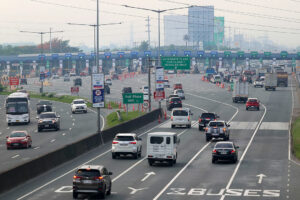
Redesigning tollways
San Miguel Corp. is reportedly set to start in the next 12 months on three tollways in Luzon that will cost an estimated P300 billion. The three projects are the Northern Access Link Expressway or NALEX, the Southern Access Link Expressway or SALEX, and the first phase of South Luzon Expressway Toll Road 5.
NALEX will run from the National Capital Region (NCR) to the international airport in Bulacan which is now being built, and then to Masantol in Pampanga and then Tarlac City. SALEX, meantime, will connect the Bulacan airport to the NAIA complex in Pasay City via a shoreline tollway. The Bulacan airport is a San Miguel project, while the same group also won the bid to rehabilitate NAIA.
Over in Southern Luzon, the first phase of SLEX Toll Road 5 will run from Lucena to Gumaca in Quezon. SLEX T5 is planned to go all the way to Matnog in Sorsogon. San Miguel currently operates SLEX all the way to Sto. Tomas, Batangas, and then the STAR tollway to Batangas City. It also operates the Skyway from Alabang to Balintawak.
I believe the construction of new tollways is a good opportunity for us to improve transportation efficiency. But we should also take advantage of these new projects to incorporate sustainable practices. After all, roads take up space. In short, by using a limited resource like land for roads, this will be at the expense of something else, like a farm, for instance.
Thus, in planning new roads, we must already integrate innovative features that can also enhance our quality of life. These may include, as far as practicable, solar panel parasols over bike and pedestrian lanes, the use of plastic in road construction, greenery, water impounding systems, EV charging stations, and emergency brake ramps, among others.
Sustainable road construction is not easy and can be expensive. But this should not deter us from building infrastructure that is environmentally friendly, resilient, and inclusive. I advocate that the government require these elements, despite the additional cost they entail, in all new road constructions, especially those that are proposed by the private sector.
My limited research points to the following benefits: solar panel parasols covering bike and pedestrian lanes have the dual benefit of generating energy and at the same reducing carbon footprint. They also offer much-needed shade from direct sunlight for cyclists and pedestrians. The energy produced can be used to power streetlights and traffic signals, or small buildings. They might produce enough energy to power even in charging stations for electric vehicles.
An example is the SolaRoad project in the Netherlands, which integrates solar panels into bike paths. The project powers streetlights and nearby homes. Another example is the 32-kilometer highway Daejon and Sejong in South Korea which has a bicycle lane in the middle that shields cyclists from the sun and generates power at the same time.
Pathways and bike lanes shaded by solar-panel parasols also make cycling and walking more comfortable. It can encourage more people to use sustainable modes of transport, and thus help reduce traffic congestion and vehicle emissions. Solar parasols also power lighting for the safety of night-time users.
Another suitable intervention is the use of recycled plastic waste in road construction. Technologies for “plastic roads” have been pioneered in India and the UK, where recycled plastic is added to asphalt. In Chennai, India, over 1,600 kilometers of roads built used plastic waste, which reportedly improved road durability while reducing construction costs. Plastic-infused asphalt can reportedly withstand extreme temperatures and heavy traffic better than traditional materials.
Then there is the need to integrate greenery along highways, such as planting trees and shrubs, which can help reduce noise pollution and improve air quality. It is highly recommended as well that native species are used along roadways, to create “green corridors” that provide habitats for wildlife. Greenery is also known to reduce stress and improve mental well-being for drivers and pedestrians.
More important is the effective integration of flood mitigation and water impounding systems that can help manage stormwater runoff and reduce the risk of flooding. These systems should be able to capture and store rainwater, so as not to overwhelm drainage systems. Impounded water can have non-potable uses such as for fire emergencies and irrigating road greenery. Properly managing stormwater runoff can also help prevent contaminants from roads, such as oil and heavy metals, from entering rivers and lakes and bays.
Another item noticeably missing from our tollways are emergency brake ramps or runaway ramps for vehicles, especially trucks, with brake failure. Emergency brake ramps are essential safety features for highways, especially in areas with steep gradients, as they can prevent catastrophic accidents in case of brake failure. We need escape routes for out-of-control vehicles.
There is also now the urgent need for charging stations for electric vehicles or EVs. This can encourage the use of EVs, and thus help reduce greenhouse gas emissions from the transportation sector. Accessible charging infrastructure along highways will also allow long-distance travel feasible for EV owners. EV charging stations, which can be powered by solar panel parasols along the highway, can also create jobs and opportunities for local economies.
Requiring all new highway and tollway constructions to incorporate these initiatives can help address environmental concerns and enhance safety, comfort, and inclusivity for road users. They can improve the overall user experience, making journeys more pleasant and reducing stress. We need a holistic approach to infrastructure development, ensuring that highways and tollways serve the needs of present and future generations while protecting the environment and promoting economic growth.
Marvin Tort is a former managing editor of BusinessWorld, and a former chairman of the Philippine Press Council



